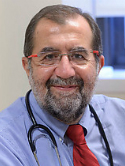High-dose induction chemoradiotherapy followed by autologous bone marrow transplantation as consolidation therapy in rhabdomyosarcoma, extraosseous Ewing's sarcoma, and undifferentiated sarcoma Journal Article
| Authors: | Boulad, F.; Kernan, N. A.; LaQuaglia, M. P.; Heller, G.; Lindsley, K. L.; Rosenfield, N. S.; Abramson, S. J.; Gerald, W. L.; Small, T. N.; Gillio, A. P.; Gulati, S. C.; O'Reilly, R. J.; Ghavimi, F. |
| Article Title: | High-dose induction chemoradiotherapy followed by autologous bone marrow transplantation as consolidation therapy in rhabdomyosarcoma, extraosseous Ewing's sarcoma, and undifferentiated sarcoma |
| Abstract: | Purpose: To improve response and survival rates in patients with high- risk rhabdomyosarcoma (RMS), extraosseous Ewing's sarcoma, and undifferentiated sarcoma, we used a short course of induction with multiagent chemotherapy, hyperfractionated radiotherapy, and surgery when possible. Consolidation was with intensive chemotherapy and autologous bone marrow transplantation (ABMT). Patients and Methods: Twenty-six patients (21 with RMS, three with undifferentiated sarcoma, and two with extraosseous Ewing's sarcoma) were entered onto the protocol between June 1990 and March 1994. Induction consisted of ifosfamide, etoposide, doxorubicin, doctinomycin, cyclophosphamide, and vincristine, and a split course of hyperfractionated radiotherapy. Patients who attained a complete response (CR) or good partial response (GPR) received consolidation with high-dose melphalan and etoposide followed by ABMT. Results: Of 26 previously untreated patients 19 (73%) achieved a CR (n = 13) or GPR (n = 6) at the completion of induction and underwent ABMT. Two-year overall survival (OS) was 56% (95% confidence interval [CI], 36% to 76%) and progression-free survival (PFS) was 53% for the whole group (95% CI, 33% to 73%). Conclusion: Consolidation of response by myeloablative chemotherapy was well tolerated. Split-course hyperfractionated radiotherapy did not increase the rate of local control. The results of this short-course therapy were comparable to previous therapies of 1 to 2 years' duration. Induction and consolidation chemotherapy, as well as radiation dose, could be further intensified, since no death due to toxicity occurred among these patients. |
| Keywords: | adolescent; adult; cancer chemotherapy; cancer survival; child; clinical article; aged; aged, 80 and over; child, preschool; disease-free survival; cancer surgery; survival rate; clinical trial; doxorubicin; skin toxicity; cancer radiotherapy; combined modality therapy; drug megadose; antineoplastic agent; infection; etoposide; stomatitis; antineoplastic combined chemotherapy protocols; radiotherapy dosage; cyclophosphamide; melphalan; vincristine; clinical protocol; radiation injury; ifosfamide; ewing sarcoma; fever; sarcoma; gastrointestinal toxicity; infant; radiation dose fractionation; dactinomycin; neoplasms, germ cell and embryonal; mesna; rhabdomyosarcoma; bone marrow transplantation; sarcoma, ewing's; transplantation, autologous; hemorrhagic cystitis; hematologic disease; intravenous drug administration; autologous bone marrow transplantation; humans; human; male; female; priority journal; article |
| Journal Title: | Journal of Clinical Oncology |
| Volume: | 16 |
| Issue: | 5 |
| ISSN: | 0732-183X |
| Publisher: | American Society of Clinical Oncology |
| Date Published: | 1998-05-01 |
| Start Page: | 1697 |
| End Page: | 1706 |
| Language: | English |
| PUBMED: | 9586881 |
| PROVIDER: | scopus |
| DOI: | 10.1200/JCO.1998.16.5.1697 |
| DOI/URL: | |
| Notes: | Source: Scopus |
Altmetric
Citation Impact
BMJ Impact Analytics
MSK Authors
Related MSK Work















